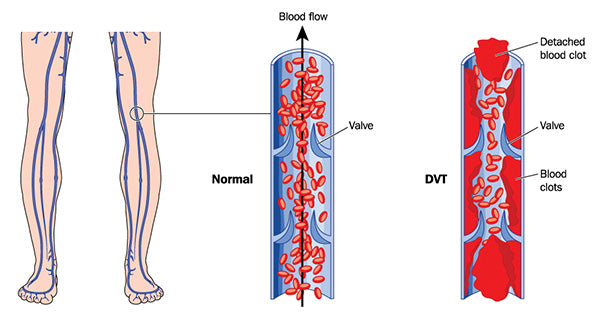Understanding Compression Sock Levels: Firm Compression Socks
We continue our deep dive into the five main levels of compression with this guide to firm compression socks. We’ll explain what firm compression does and who should consider wearing firm compression socks. Then, we’ll take a closer look at Deep Vein Thrombosis (DVT), one of the most common conditions that firm compression socks are used to manage.

What does firm compression do?
Firm compression falls into the 20-30 mmHg range. (mmHg stands for milligrams of mercury, which is a unit used to describe the range of pressure that different levels of compression provide.) Firm compression is the first compression level that can help to address existing conditions instead of merely preventing them or maintaining already healthy legs.
Some conditions that this level of compression can help with include:
- Pre/post vein procedures
- Lymphedema
- Mild venous insufficiency
- Pre-/post-surgery (Sclerotherapy, Phlebectomy, Vein stripping, Orthopaedics, etc.)
- Mild swelling/edema
- Superficial thrombophlebitis
- Helps to prevent varicose and spider veins during pregnancy
- Helps to prevent recurrence of venous ulcerations
- Helps to prevent moderate to severe varicose veins at all life stages
- Helps to prevent Deep Vein Thrombosis (DVT)
While firm compression can help manage a wide range of conditions, individuals may still need to move up to stronger levels of compression for more acute conditions, such as severe lymphedema and Chronic Venous Insufficiency (CVI).
Who should use firm compression?
Firm compression socks are appropriate for individuals already at risk for a variety of conditions, such as varicose veins and venous ulcerations. If you have certain venous procedures coming up, such as sclerotherapy, wearing firm compression socks can help promote good circulation before and after surgery. Of course, you should always talk to your doctor before wearing compression socks either before or after a medical procedure. Firm compression is also the most common level used to manage Deep Vein Thrombosis (more on this in the next section).

What is Deep Vein Thrombosis?
Deep Vein Thrombosis is a potentially dangerous condition that occurs when a blood clot forms deep in the veins of the body. These clots usually appear in the legs, though they may form in other places as well. Common symptoms of DVT include warmth and tenderness over the vein, pain or swelling in the affected body part and skin redness. The vein may swell due to the clot, causing a condition named thrombophlebitis.
The blood clot can break off and drift towards the lungs, which can result in a pulmonary embolism, or blocked artery. Pulmonary embolisms are extremely dangerous and can even be life-threatening.
Multiple factors increase your risk of DVT, including:
- Already having a blood clot or DVT
- A family history of DVT
- Being over the age of 40
- Being on bed rest
- Living a very sedentary lifestyle
- Pregnancy and giving birth
- Blood clotting disorders
- Being overweight or obese
- Injury to the vein
- Other conditions such as heart disease, lung disease and irritable bowel disease (IBD)
Why does compression help with DVT?
Firm compression socks can help to prevent deep vein thrombosis by promoting good circulation. If blood pools in your blood vessels, the platelets in your blood are more likely to stick together, which forms a clot. This kicks off a chain reaction that causes the blood clot to grow as more and more platelets are triggered to bond together.
Encouraging blood to keep flowing instead of pooling is an important factor in discouraging the formation of clots. Compression socks accomplish this by providing just the right amount of pressure to keep the blood flowing. Instead of letting the blood settle in your lower body, the pressure provided by the compression fabric keeps the blood moving back towards your heart.

What are some other lifestyle tips?
Many people who wear firm compression socks experience discomfort and even pain due to their venous conditions. Compression socks can help with this by increasing circulation, but there are additional lifestyle changes you can make to ease your discomfort and improve your blood flow.
Elevating your legs with a leg rest for 20 minutes at the end of the day helps blood and other fluids flow back towards your core. This helps boost circulation and reduce lower body swelling. To get your legs above the level of your heart, use a contoured leg rest for proper elevation with added comfort.
Eating a healthy diet low in fats and salt will help promote good circulation as well as a healthy weight. Regular exercise, especially cardiovascular activities, will get your heart pumping, increasing circulation over the short term and strengthening your heart and lungs in the long run.
There are many firm compression stocking options available, including ankle and crew socks, knee-high and thigh high stockings and pantyhose. If you’re looking for firm compression garments, you can shop our entire collection here.
Written October 2019 | Page Last Updated February 2022
Kaki Zell - Vice President of Sales, Marketing, eCommerce at Legs-4-Life LLC Kaki holds a Bachelor of Science degree in Business Administration and Management from Virginia Polytechnic Institute and State University. She’s been working in the medical device industry for over 11 years and currently serves on the Board of Directors for the Greensboro Science Center.
Sources
Medicine Net. “7 DVT Early Symptoms, Tests, Prevention, Causes & Treatments” https://www.medicinenet.com/deep_vein_thrombosis/article.htm
Web M.D. “Blood Clots - How They Form and Common Causes” https://www.webmd.com/dvt/blood-clots
